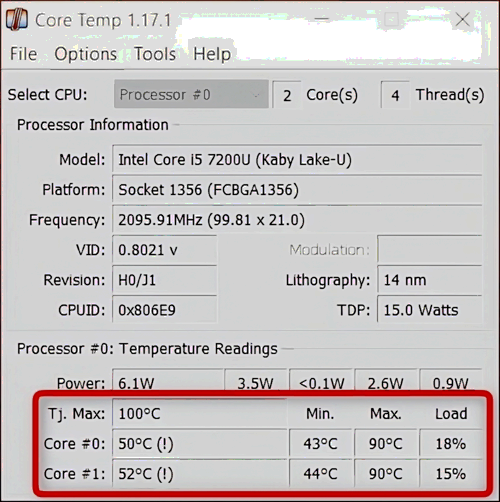Key Takeaways
- Thermal paste is crucial for heat transfer in laptops. substitute it every 3–4 years or if your laptop has consistent performance drops or shutdowns.
- Regularly cleaning the laptop interior is also important to keep temperatures low.
- Replacing thermal paste can make your laptop run faster by keeping the processor cool and allowing it to reach higher boost clock speeds.
Frustrated because your trusty old laptop overheats or even shuts down all the time? Perhaps you don’t have to substitute it just yet. One cheap way to fix the issue is by replacing the thermal paste.
What Is Thermal Paste?
Thermal paste, or thermal compound, is a thick paste that helps heat transfer from one object to another. In the context of a laptop, it sits between your CPU (central processing unit) and optional discrete GPU (graphics processing unit), and a copper or aluminum heat sink. The heat from your processor transfers into the heat sink, which in turn gets cooled off by a fan.
The surface of the processor’s heat spreader and that of the heat sink are imperfect on a microscopic level. This makes it possible for tiny pockets of heat-insulating air to get trapped between them. Thermal paste fills in those gaps and makes it easier for heat to proceed across the interface.
Without thermal paste, the processor wouldn’t be able to dissipate enough heat. Your laptop could overheat and shut down or slow down its performance. What’s worse is that you’d risk permanently damaging your processor.
Your laptop already has thermal paste inside of it. The laptop manufacturer applied it and tested your device before shipping it off. While the stuff used in factories is slightly lower quality than enthusiast-grade thermal paste, it’s good enough to last around three years. If you bought your laptop recently, your thermal paste is something you should only worry about in a few years’ time.
How Often Does My Laptop’s Thermal Paste Need Replacing?
Your laptop’s CPU is designed to run close to its maximum safe operating temperature, which is usually around 100°C. When your laptop works hard for extended periods, it’ll output a lot of heat, and your CPU will automatically reduce its clock speed and voltage to impede overheating. We call this process thermal throttling. In truly disastrous situations when thermal throttling alone can’t lower the temperature, the laptop will shut down to impede permanent damage.
Because your laptop has to constantly bear high temperatures, the thermal paste dries out over time. When that happens, it can no longer do its job as effectively because it can’t fill the tiny gaps between your CPU and heatsink, and it loses some of its thermal conductivity. Based on my go through, you’ll get the best results by reapplying thermal paste three to four years after the date of purchase or last application.
You might get marginally lower temperatures and better performance if you substitute the paste annually, but I didn’t notice any substantial difference with such frequent changes. Nevertheless, you’ll see a considerable difference if you keep your laptop dust and pet fur free. Use a can of compressed air once or twice a month to quickly clean the inside of your laptop.
Replacing the thermal paste might have a nice bonus side effect of making your laptop run faster. This is because your processor increases its clock speed automatically if it runs sufficiently cool, and it’ll keep these “boost” speeds for longer, too.
Tearing down your laptop to substitute the thermal paste can be a risky procedure. It has many delicate parts, such as ribbon cables, a circuit board, and a battery. If you aren’t careful you can permanently damage your laptop, so it’s best to have this procedure done by a technician in a certified service center if you aren’t confident.
How to Check if My Laptop Needs New Thermal Paste
Although your laptop could always use a thermal paste reapplication after a few years, you should first check your laptop’s CPU and GPU (if you have a discrete GPU) temperature. And no, touching the back of your laptop isn’t a scientific way to check whether it’s overheating. In fact, the chassis is designed to get hot as there’s a heat spreader next to the fan, whose job is to improve the surface area for the cooling system.
The easiest way to check your CPU’s temperature is by installing a free temperature monitoring program. We propose Core Temp for basic monitoring or HWMonitor, which can also check GPU temps. After installing Core Temp, you can see the Tj. Max (the maximum safe operating temperature), current, minimum, and maximum temperatures for each core.
If Tj. Max is grayed out, look up your CPU model on the manufacturer’s website to check its maximum temperature. You can’t really tell much while your computer is idling, so it’s best to fire up a demanding program. Launch a video game, video editor, or even an internet browser with many tabs open.
After using the laptop for about 15 minutes, check the current temperature on Core Temp. While the “normal” temperatures vary based on your CPU model, sustained temps near the Tj. Max and frequency speeds dropping below the base clock suggest that your laptop is overheating and could use new thermal paste.
Thermal paste does its job out of sight, but you’ll know when it’s given up the ghost. A quick dusting paired with a fresh thermal paste application can revitalize your aging laptop and ensure it sees a couple more years on your desk.


